The technique to apply lettering to a bottle may or may not provide
information on how to narrow the date on soda and mineral water bottles.
Below are the different types of lettering that are found on Soda and
Mineral Water bottles:
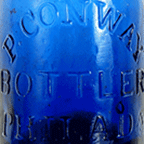
|
Embossed, glass circ:
1818-1920+
This technique used to get the glass embossed is to cut a
reverse image of the lettering into the mold that the glass will
be blown in to shape the bottle. When the glass is blown
into the mold, the glass being pressed into the molds lettering,
it will create an inverse image on the bottle. |
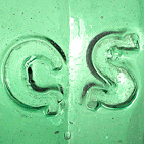
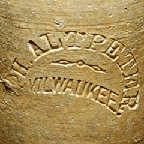
|
Impressed, glass circ:
1855-1860, pottery circ: 1825-1910
Getting the lettering on a glass bottle to be impressed can be
accomplished with two different techniques. The first
would be to alter the mold in a way the lettering is not cut
into the mold, but raised. It would then push into the
face of the bottle being blown into it. The second would
be to use a stamp with raised lettering that would be pushed
into the face of an already blown bottle. The former
technique would have the impressed lettering always in the same
place on the bottle and the later technique would result in
different placement of the lettering.
The same technique
of stamping was used on pottery bottles.
|
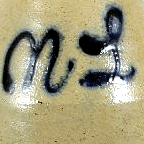
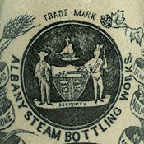
|
Glazed, pottery circ:
1845-1920+
Lettering that is glazed can be of two types, but in both cases
this lettering is applied to the pottery container before the
final firing. The first type is a fee form hand
decoration, usually initials of some sort that are applied as a
slip. These are sometimes added to pottery bottles that
have impressed lettering. The second type is more uniform
and is the result of a rubber or similar materialed stamp that is pressed
into liquid glaze and stamped on the bottle. In another
technique, a paper label with the glaze printed on it is
attached to the bottle before firing. During the firing
the paper burns away and glaze is left affixed to the bottle. |
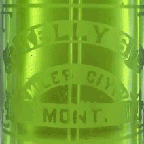 |
Etched, glass, circ:
1880-1920+
There are two ways that etched lettering can be applied to a
bottle. One is to coat the bottle is some sort of wax or
other material that has the area where the lettering is going to
occur uncoated or exposed glass. An acid can then be
applied to etch the glass. The second technique is for a
metal stencil, with the lettering cut away placed on the bottle
and then it is sand blasted. In both these techniques the
exposed area of glass is eroded leaving a white residue as the
lettering. |
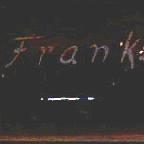 |
Engraved, glass, circ: 1875-1900
The appearance in the lettering of an engraved bottle is similar
to a etched one, but is usually not as exacting. To
engrave lettering on a bottle involves using a copper or some
other metal or stone wheel and using the wheels edge to cut the
lettering into the glass. This was often done when a
bottler or brewer acquired bottles from another firm and wanted
to mark them with their name or mark. The same technique
is occasionally used to grind lettering off an embossed bottle. |
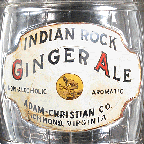
|
Label Under Glass, glass: circ:
1885-1920+
This
lettering is actually on a printed label that is applied to
recessed area on the bottle and is covered with a very thin
glass covering.
It is generally used on soda fountain syrup bottles to identify
the flavor of the syrup and dispensing bottles or jars to
advertise a specific product. |
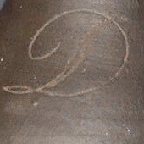 |
Scratched, pottery, circ:
1840-1900
This
technique used to apply lettering in this way is to scratch the
lettering on a glazed but unfired bottle. This would
expose the clay and provide the necessary contrast to make the
letters readable. |
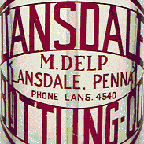 |
Applied Color Label, glass circ:
1934-Today
Also known as a "Painted Label"
or "Pyro." This type of lettering is
a glass based slip that is silkscreened onto an annealed bottle,
which is then refried to fuse the design to the glass. A small
indentation near the base of the bottle was used by the
machinery to properly align the bottle as the design was
applied. This technique was introduced in 1934 and in in
use thru today. |

